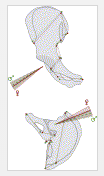The three-dimensional orientation of the acetabulum and its relation with the orientation of the femoral neck
Noémie Bonneau , Michel Baylac , Olivier Gagey, Christine Tardieu
Source - http://www.sciencedirect.com/science/article/pii/S0047248414000177
Journal of Human Evolution
Abstract
In humans, the hip joint occupies a central place in the locomotor system, as it plays an important role in body support and the transmission of the forces between the trunk and lower limbs. The study of the three-dimensional biomechanics of this joint has important implications for documenting the morphological changes associated with the acquisition of a habitual bipedal gait in humans. Functional integration at any joint has important implications in joint stability and performance. The aim of the study was to evaluate the functional integration at the human hip joint. Both the level of concordance between the three-dimensional axes of the acetabulum and the femoral neck in a bipedal posture, and patterns of covariation between these two axes were analysed.


First, inter-individual variations were quantified and significant differences in the three-dimensional orientations of both the acetabulum and the femoral neck were detected. On a sample of 57 individuals, significant patterns of covariation were identified, however, the level of concordance between the axes of both the acetabulum and the femoral neck in a bipedal posture was lower than could be expected for a key joint such as the hip. Patterns of covariation were explored regarding the complex three-dimensional biomechanics of the full pelvic-femoral complex. Finally, we suggest that the lower degree of concordance observed at the human hip joint in a bipedal posture might be partly due to the phylogenetic history of the human species.